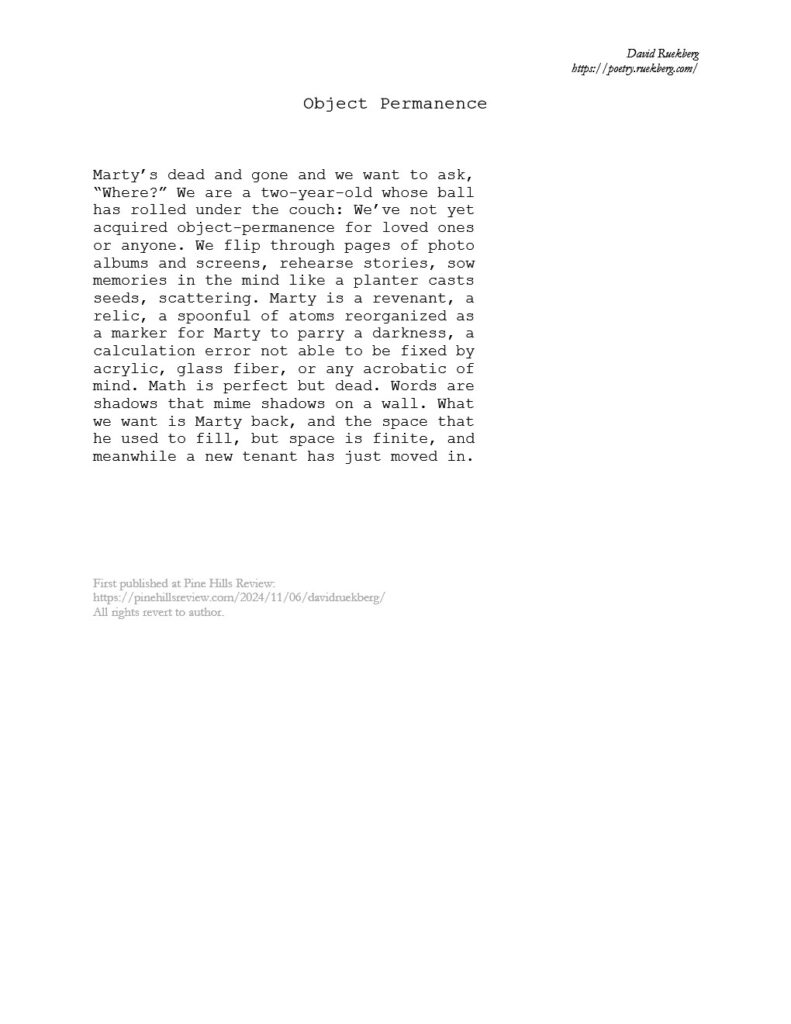

Poetry and other words
Thoughts on poetry: writing it, reading it, tearing it apart, putting it back together.

A few years ago I started a writing project called Weather Report, about internal and external weather: the changing landscape of my spiritual evolution/dissolution, and global warming. It seems like a lot to roll into one ball, but you understand that one can't really separate the environment from what one is.
However, this post is not about that collection, which languishes in various slush piles. The lack of attention did cause me a brief period of despair and self-doubt, but against or despite or irrelevantly to my will, I found myself working in a form I call "Little Coffins." In about a year's time I found I had written about 45 poems mostly on purpose which I collected into a new manuscript I'm calling Marble and Rasp.
The name I gave the form doesn't so much have to do with my despair and self-doubt as with the shape of the poems: They appear in a rectilinear layout created by using a monospaced font and the same number of characters per line to create a poem that is right-justified without tracking or kerning. That's one reason I call them little coffins. They're boxy (most of them; see below). In terms of craft, the form puts pressure on the ideas, a little like a sonnet, but without a rhyme scheme, meter, or length constraints.
The first time I heard of this form was thirty years ago in a poetry workshop at Writers & Books, our literary writing and reading center in Rochester, NY. The instructor told us he had spent a week with another poet holed up in a house in the desert just writing. One day they challenged each other to only write poems that were completely justified on both margins. They were doing this on typewriters. I think he presented it to us in the same way Stephen Dunn once explained his tendency towards tercets--as a “compositional strategy.” At the time I thought it was a dumb idea.
In January, 2021 I went out for a winter day’s walk. I sometimes compose out loud while I’m walking, recording on my smartphone. I was looking at the clouds and the crust of snow outlining the suburban landscape and the dendritic trees against the atypically blue Rochester skies and the poem “Emendation” sprang out of my mouth. The next morning I typed it up, and wholly by accident the way I broke the lines they were almost perfectly right-justified. So I tinkered with the poem to make them align. Then I remembered the dumb exercise and laughed.
That June, attempting to protect my garden from marauding woodchucks, I accidentally caught a rabbit in my Havahart, and the next day her kitten. “Object Lesson” sprang out all of a piece, aligning on both margins with only minor tinkering. After sending it off to my writing group, I dismissed it as a lark. In September I wrote, “Object Constancy,” and something in the poem seemed to beg to be crammed into this form. I think it was the way they had a recognizable structure: introduction, development, conclusion, but without obvious logical hooks. Then “Slot Canyon” emerged, kind of on purpose, and I was off.
Fortunately, I have the advantage of a word-processor rather than a typewriter, which makes it a lot easier to edit. I realized after sending out “Emendation” that it might drive editors crazy to make my fonts accord with theirs. I realized this form would require composing in a monospaced font (like what you had on old typewriters, and which “Courier New” imitates) so that everyone (author, editor, typesetter) agreed about line length. I had typed up “Emendation” in Garamond, my preferred font, so it took some editing to make it conform. In fact, it was one of the hardest poems in this collection to align, since I had really liked it the way it was. But writers get used to merciless revision.
When I get stuck for the right line length I refer to the Thesaurus, and the site RhymeZone.com, which has a filter to let me search synonyms by word length, but most of the time I have to fall back on my own ingenuity to get not only the right number of characters in a line but also the right words.
I call these poems “little coffins” partly because of their shape, and partly for the reason suggested in the line from “Object Constancy”: “Words are shadows that mime shadows on a wall,” a twisted allusion to Plato’s Allegory of the Cave. There’s the ideal reality, then there’s our perception of reality, then there’s our expression of our perception, three degrees removed from the ideal.
Towards the end of the manuscript some of them have a ragged last line. I'm not going to say why here. If it ever gets published maybe you will come up with a theory if you read it.
I tried to find out who that instructor was. For some reason I thought it was Campbell McGrath, but he responded to my email very politely and firmly that he had no idea what I was talking about. After discovering The Meadow in the Vermont home where I was sitting Fitzie, Anni MacKay and Doon Hinderyckx's Tibetan Terrier, it seemed sure that it was James Galvin who told the story of the typewriter exercise. I wrote to what I thought might be his email address, but either I was mistaken, or he ignored me, or something came up. At any rate, I still don’t know who it was for sure.
So far I've gotten one of these published. It's currently the second poem in the collection, "Weaver" (below), which I initially wrote in Ross White's September, 2021 Grind which was published in The Orchards Poetry Review. They weren't able to use a monospaced font as I had hoped, due to layout constraints, but were able to approximate the effect by manually adding spaces.
The Orchards happens to be published by Karen Kelsay, who also runs Kelsay Books, which published my first book, Where Is the River Called Pishon? A coincidence, I'm sure. Thanks to Karen Kelsay and the rest of the staff at Kelsay Books and The Orchards!

 My point is, I think these poems I submitted to Bloom are enough alike that they might appear to have been written by the same person. I think I was in the same mood (as opposed to mode) when I wrote them, though they were written days or even months apart. This is not so long, considering that the poems included in my first book were written years apart.
The time between my writing of poems and getting them into an actual book is shrinking. My first book, Where Is the River Called Pishon? includes poems written between 1998 and 2013. It wasn’t published until 2018. Tony once told me that, as a poet, he was a slow learner. He’s got nothing on me for slow. I’m not bragging, and I probably shouldn’t admit this, but it’s the truth, and maybe it will inspire some poet living in a garret somewhere not to throw himself off a bridge into the Thames waiting to get published.
My second book, Hour of the Green Light, came faster. I think I wrote the earliest poem in that collection in 2009. It was published this month, January 2021 (though it was finished two years ago).
The poems published on Bloom today were all written in the last two years. Progress! I am currently planning to include them in my third collection, which revolves around the problems of climate change and marriage. Maybe that sounds like a screwy conjunction of topics, but I believe both can have happy endings if everyone takes responsibility for their actions and works consciously to create the conditions for mutual kindness.
Thank you to the kind editors and staff at Bloom, especially Evelyn Somers and Alice Stephens.
My point is, I think these poems I submitted to Bloom are enough alike that they might appear to have been written by the same person. I think I was in the same mood (as opposed to mode) when I wrote them, though they were written days or even months apart. This is not so long, considering that the poems included in my first book were written years apart.
The time between my writing of poems and getting them into an actual book is shrinking. My first book, Where Is the River Called Pishon? includes poems written between 1998 and 2013. It wasn’t published until 2018. Tony once told me that, as a poet, he was a slow learner. He’s got nothing on me for slow. I’m not bragging, and I probably shouldn’t admit this, but it’s the truth, and maybe it will inspire some poet living in a garret somewhere not to throw himself off a bridge into the Thames waiting to get published.
My second book, Hour of the Green Light, came faster. I think I wrote the earliest poem in that collection in 2009. It was published this month, January 2021 (though it was finished two years ago).
The poems published on Bloom today were all written in the last two years. Progress! I am currently planning to include them in my third collection, which revolves around the problems of climate change and marriage. Maybe that sounds like a screwy conjunction of topics, but I believe both can have happy endings if everyone takes responsibility for their actions and works consciously to create the conditions for mutual kindness.
Thank you to the kind editors and staff at Bloom, especially Evelyn Somers and Alice Stephens. Genesis 2:10-14 New Jerusalem Bible
The title of my book refers to the Pishon, the only river mentioned in the second creation story of Genesis whose location has not been identified. Various theories include the Nile; a now-dry channel running from Medina to Kuwait; and even the Danube, associated with this mosaic in Qatr, Libya, perhaps depicting a thirsty pilgrim, or Adam (© livius.org).Submitting poems to journals is an arduous process, and apparently my way of implementing it makes it more so. I have a personality defect which makes me sometimes take things too seriously, and sometimes not seriously enough, (but that will be the subject of another post). So everything takes a little longer as I consider, evaluate, reflect, reassess, grumble, consider again, and eventually come to a resolution. Or not.The advent of the paperless world has made submitting poems easier, though electronic vehicles come with their own challenges, as you know. Mostly, though, it's easier. In the old days I had to stuff envelopes and mail them out, a more arduous task than it might sound to those whippersnappers who have only been on the receiving end of an envelope. The first step in submitting work was to research journals that might be a fit for my work. In the 1990s, when I began to seriously engage the mechanics of publication, I consulted a three-inch thick directory of little magazines and small presses called The Directory of Little Magazines and Small Presses. When I found some I thought sounded interesting, either because of their titles or subject matter (various indices indicated each), if I were responsible I visited the local Borders or independent bookstores (neither of which exist in the Rochester area any more, except Greenwood Books in Rochester and Lift Bridge books in Brockport), or tried to find them in a library (sometimes I was able to locate a few in the Rochester downtown branch or, rarely, at the University of Rochester). If I were less responsible, I just shot in the dark (against my nature, at least the greater part of it). Having narrowed the field one way or the other, I compiled 3-5 poems in Word document batches according to style or content. Then, usually during school vacations, I filled our large dining room table with the printed-out batches, placed cover letters atop them, folded SASEs for responses and return of manuscripts, and then stuffed stamped envelopes with the lot, and hauled the bundle to the post office. A few months later the rejections rolled in, and I would repeat the process over the next school break. My wife told me she had heard of a poet who kept his batches in a cubby he had inherited from a local post office, and as soon as a rejection came in sent out a new batch, but I never got that organized. In those days, few journals accepted simultaneous submissions, so the cycle was slow. As those of you know, now the process is much easier. Go to the website of the journal you hope will be interested in your work, read a few sample poems to see if it is a good fit, click the "Submit" link, and upload your work. Most sites have some kind of submission manager, such as Submittable, to help you keep track of your submissions. Some use the Ur-submission manager, Devin Emke's "Submission Manager," that all presses accepting work online used to use, and that now only a few, such as Cider Press Review, still do. Maybe they've invested too many of their few dollars and precious time to move over to Submittable, which most journals use, or maybe they're just very nostalgic. Some, such as Diode, still accept work only through email. And some very respectable journals, such as The Southern Review, still rely on the post office, which probably narrows the field to those who are really serious -- or who can't deal with the computer. Though the process is easier, it doesn't necessarily mean one's chances of getting a poem or story published is much greater. There's a proliferation of online poetry journals, and more people seeking publication for poetry than fifty years ago. Presumably the same problem exists now as did then: more people writing poetry than reading it, but at least online publishing makes it easier for people to access creative work, as noted in Stephanie Burt's 2015 article in the New Yorker, "The Persistence of Lit Mags." Regardless of success, I don't write to get published. Several times in my life I've given up on trying to get in print, but after a few depressed weeks of not writing, picked up my fountain pen again and started. Not to get published, but just because I couldn't help it. Of course, being back in the saddle riding towards publication does put a happy pressure on what I write -- or at least what I choose to revise -- to be clearer, wiser, funnier, and altogether more effective as a writer than if I were just fiddling with my navel in a journal. Wish me luck.
 ces that drive us: love, grief, despair and hope. “Dirt and instructions” coalesce and point to answers not given but suggested, offer “somewhere to overnight/before rain, and winter,” promise love as surrender, “and no one asking questions.” Where Is the River Called Pishon? is an irresistible book that asks to be read and read again.
—Pablo Medina, author of The Floating Island (poems) and Cubop City Blues (a novel), and thirteen other works, including an acclaimed translation of Lorca’s Poet in New York.
ces that drive us: love, grief, despair and hope. “Dirt and instructions” coalesce and point to answers not given but suggested, offer “somewhere to overnight/before rain, and winter,” promise love as surrender, “and no one asking questions.” Where Is the River Called Pishon? is an irresistible book that asks to be read and read again.
—Pablo Medina, author of The Floating Island (poems) and Cubop City Blues (a novel), and thirteen other works, including an acclaimed translation of Lorca’s Poet in New York.
David Ruekberg's probing debut collection renders the world for readers, in many senses of the word. His poems distill experience to concrete moments of "magnolia blossom. . .Dutch Catholic schoolgirls. . .traffic's wreathed whine." They also present a world in flux. Past and present, creation and destruction coexist: a "half-world below heaven," where "the species will follow all species…it will die out"; where "The law commands the cells' bloom/in the body, light's intercourse with matter, the ions' banquet/of rust." Ruekberg marvels at it all, even at questions about the meaning of existence: "History is the ultimate act of faith. Plant an atom in darkness/and you sow a cosmos." By turns playful and solemn, the poems are generous invitations to consider the origins of life and its inevitable ends, to remember the fact that, at least sometimes, "everything murmurs and winks, as if holy."
 Al Abonado, poetry DJ at WAYO-FM[/caption]
Al Abonado, poetry DJ at WAYO-FM[/caption]